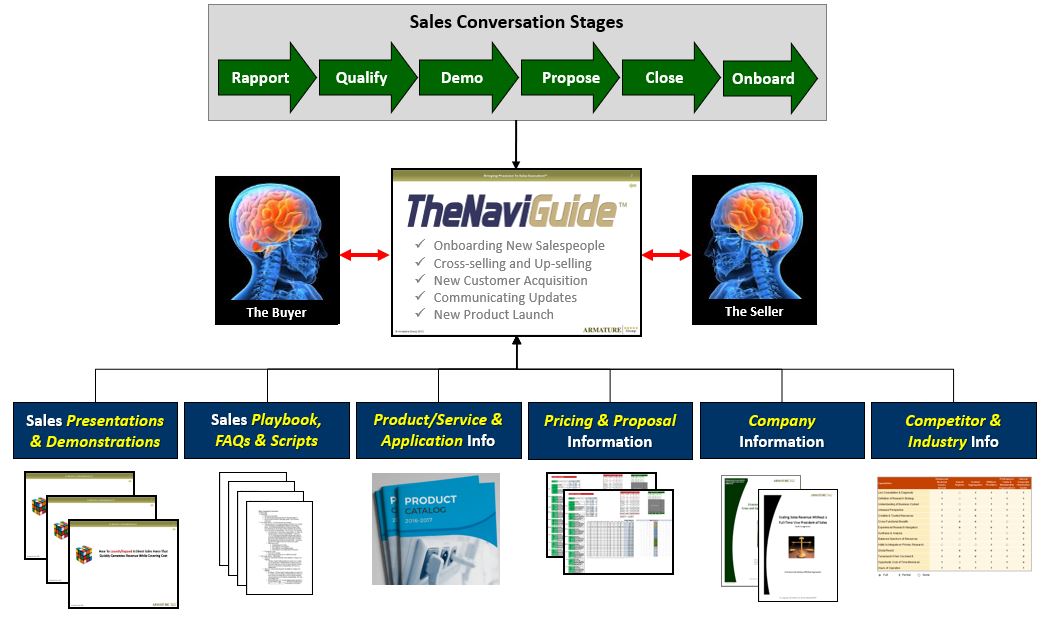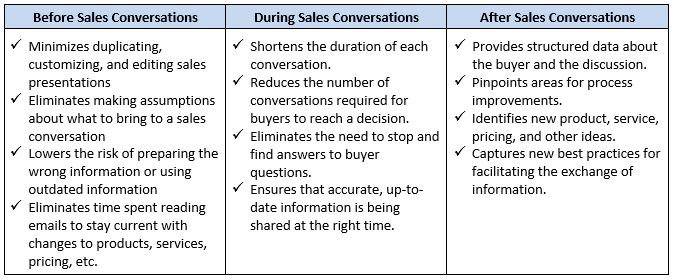Time Is The Enemy When Onboarding New Salespeople
In a perfect world, new salespeople would immediately begin to sell and generate opportunities. This is true for new insurance producers, accounting firm partners, and engineering firm sales engineers. It’s also true for new software inside salespeople, manufacturing field salespeople, and all other new salespeople.
Unfortunately, it takes time to onboard new salespeople. But time is something that business leaders can’t afford. Large, financially strong companies want to reduce onboarding time and cost to add bottom line profits. Start-ups want to reduce onboarding time and cost so they can afford to hire salespeople.
So, why does it take so long to onboard new salespeople? How can we enable them to immediately begin to sell and generate opportunities?
What Blocks New Salespeople from Immediately Beginning To Sell and Generate Opportunities?
To answer this question, we observed over one thousand new salespeople. Where are new salespeople spending time? We found new salespeople spending time on four categories of activities.
First, new salespeople spend time learning company offerings and operations by:
- Reading documents, reviewing website pages, and watching videos.
- Taking and organizing notes on what they were learning.
- Studying and memorizing that information.
- Meeting with technical experts to ask questions.
- Attending training classes led by technical experts.
- Completing self-paced eLearning programs.
Information included:
- Products and services.
- Applications of the products and services.
- Pricing, discounts, contract terms and conditions.
- Value propositions and unique differentiation.
- Competitors and their vulnerabilities.
- Customers industries and their customers.
Second, new salespeople spend time preparing their sales approach by:
- Studying and memorizing sales playbooks, FAQ’s, and scripts.
- Listening to recordings of sales conversations.
- Participating in field sales meetings to learn from other salespeople.
- Crafting sticky notes, checklists, and scripts to help them remember what to say and do.
- Creating their own sales presentations, talking points, and scripts.
- Rehearsing their sales approach and participating in mock sales conversations.
Information included:
- Questions to understand buyers situation, problems, impact, and need to resolve.
- Explanations to demonstrate products, services, features, functions, and benefits.
- Formulas and calculations to create the right pricing and proposals.
- Negotiating points, terms, and conditions to close deals.
- Objection handling tactics across all steps of the sales conversation.
- Market knowledge i.e. industry, company, department, process, etc.
- Competitor knowledge i.e. offerings, unique differentiation, comparison points.
Third, new salespeople spend time searching for content, questions, and answers by:
- Flipping through sales presentations, playbooks, and scripts.
- Disrupting technical experts via phone call, TXT, email
and stopping by their office. - Looking for information in databases, wikis, online shared folders, and websites.
- Talking to other salespeople and their sales manager.
Content included:
- Sales playbooks and Wikis.
- Sales presentations and templates.
- Scripts and talk tracks.
FAQ’s .- Product and service sheets and manuals.
Fourth, new salespeople spend time managing/venting their frustration with the onboarding process by:
- Procrastinating before executing sales conversations.
- Avoiding internal conversations with peers, technical experts, and sales managers.
- Venting to others within the organization.
- Guessing at the right answers.
- Searching for information, rather than asking for help.
Frustrations included the:
Volume of information they needed to learn.- Lack of selling tools available for facilitating buyers during conversations.
- Unclear product and service information and language.
- Slow responsiveness of technical experts to their questions from buyers.
We observed that sales managers and technical experts are frustrated too. Five onboarding activities drive their frustration. Training new salespeople, handling their complaints, correcting their mistakes, re-explaining things, and addressing constant disruptions.
In summary, new salespeople spend little to no time selling and generating opportunities. They spend most of their time on four categories of onboarding activities. Learning company offerings. preparing their sales approach, searching for information, and managing/venting their frustration. These activities distract them from immediately beginning to sell and generate opportunities. So, how can we reduce or eliminate the time that new salespeople spend on these onboarding activities?
How Do You Reduce or Eliminate The Time That New Salespeople Spend on Onboarding Activities?
We found a new way of thinking about time spent onboarding new salespeople in a surprising place. A book called “The Checklist Manifesto: How to get things done right”.
The following quote by Dr. Atul Gawande caught our eye:
“the modern world has given us stupendous know-how. Yet avoidable failures continue to plague us…and the reason is simple: the volume and complexity of knowledge today
When modified, the last sentence is a perfect reflection of our onboarding situation. We train [new salespeople] longer, specialize [salespeople] more, use ever-advancing [sales] technologies, and we still fail [to enable new salespeople to immediately begin to sell and generate opportunities].
This is exactly what we were experiencing – – a frustrating do-loop of wasted time and onboarding failure.

Spending Time In All The Wrong Places
Dr. Gawande helped us recognize that we were spending time in the wrong places:
- Translating the stupendous know-how of our technical experts into training materials and eLearning programs. Building sales playbooks, FAQs, marketing libraries, sales presentations, and scripts.
- Properly delivering the volume of complex knowledge to our new salespeople. Delivering product, service, pricing, and other training. Coaching, mentoring, and facilitating mock sales conversations.
Unfortunately, this led new salespeople to spend time in the wrong places too. Learning company offerings, preparing their sales approach, searching for information, and managing/venting their frustration. Our approach to onboarding new salespeople blocked them from immediately beginning to sell and generate opportunities.
We trained [new salespeople] longer, specialized [salespeople] more, used ever-advancing [sales] technologies, and we still failed [to enable new salespeople to immediately begin to sell and generate opportunities]. It was time for a new approach.
Dr. Gawande shifted our thinking about onboarding new salespeople. We stopped spending time training new salespeople. We started spending time equipping them to immediately begin to sell and generate opportunities. The keyword being immediately.
How Do You Enable New Salespeople To Immediately Begin To Sell and Generate Opportunities?
This was a tough question to answer. So, we asked some basic questions. First, what is the goal of a sales conversation? We believe the goal is to reach shared understandings and agreements that preferably result in the buyer purchasing. Second, what is required for the buyer and seller to reach shared understandings and agreements? In simple terms, there is an exchange of information where the:
B
- Define and articulate their situation, problems, and priorities.
- Quantify the financial reason(s) to solve the problem.
- Identify potential solutions.
- Evaluate and compare competing solutions.
- Make a yes/no purchase decision.
Seller works to:
- Build rapport and qualify buyer problems, needs, and wants.
- Demonstrate and explain products, services, applications, and value propositions.
- Present recommendations and proposals.
- Negotiate and close the sale.
- Handle objections at any point during the exchange of information.
Third, how do you improve the exchange of information between the buyer and seller? To answer this question we observed and listened to thousands of sales conversations in five industry groups.
1. Software, information, and publishing
2. Professional service firms i.e. accounting, engineering, environmental
3. Agencies i.e. insurance, financial advisers, real estate
4. Franchises
5. Manufacturers and distributors
We observed new salespeople struggling to perform ten tasks during sales conversations including:
- Getting and keeping the buyer on the same page throughout all stages of the sales conversation.
- Validating assumptions about what buyers know and don’t know. Assumptions about the seller’s company, offerings, and differentiation. Also about what buyer’s value when determining if a vendor/partner is worthy of doing business with. And what buyers want to discuss now versus later.
- Sequencing and accurately presenting the right questions and answer options at the right time to: understand the buyer’s situation, define and prioritize buyer problems, wants and needs; clarify the impact the problems are having; establish an economic reason for solving the problem.
- Answering questions about products, services, applications, and competitors that buyers know to ask and those that they don’t know to ask.
- Accessing and sharing information including demonstrations and comparisons, pricing and discounts, case studies and testimonials, product and service information sheets.
- Presenting proposals including preparing recommendation options, pricing, and discounts, terms, and conditions.
- Testing buyers at each stage of the exchange of information for understanding and agreement.
- Switching roles between talking, viewing and listening; interpreting and preparing responses; searching for information and documents.
- Mitigating differences with buyers including frames of reference and assumptions, language and terminology, knowledge and experience, the timing of decisions, personal agendas and priorities, personality styles.
- Remembering to apply selling skills and methods, company policies and procedures, best practices, legal compliance measures.
So, observing salespeople made it clear that we needed a new approach for onboarding new salespeople. One that equipped them to facilitate the exchange of information with buyers during sales conversations.
Equip New Salespeople To Facilitate The Exchange of Information With Buyers During Sales Conversations
Unfortunately, traditional methods for onboarding new salespeople are not built for use during sales conversations. They are built to train salespeople outside of sales conversations with buyers. We tried using sales playbooks, sales presentations, sales libraries, eLearning, and multiple other tools.
But, these solutions required new salespeople to spend time learning company offerings, preparing their sales approach, and searching for information. They did not equip new salespeople to facilitate the exchange of information with buyers during sales conversations.
So, we developed a new tool for onboarding new salespeople that immediately:
- Transferred the stupendous know-how of our technical experts to salespeople.
- Delivered the volume of complex knowledge to salespeople.
- Equipped salespeople to immediately begin selling and generating opportunities.
The tool equipped new salespeople to facilitate the exchange of information with buyers during sales conversations by:
- Using a decision tree to anticipate, organize, and map the most precise conversation sequence. This includes questions, answer options, explanations, demonstrations, recommendations, comparisons, proposals, negotiations, objection handling, and closing. This enabled the conversation to be logical, easy to follow, and quick.
- Visually presenting the right questions and answer options at the right time during the exchange of information. This increased the accuracy of what was discussed while minimizing confusion and the need for verbal explanations.
- Equipping buyers to prioritize conversation topics based on their situation and problems. This increased buyer engagement and increased the relevancy of what was being discussed.
- Providing “one-click” access to information needed by the buyer and seller to complete the exchange of information. This minimized interruptions and the need to prematurely end a sales conversation to find information.
- Using plain English and simple visuals. This minimized misinterpretations and the need to ask clarifying questions.
- Embedding application of selling skills and best practices. This extracted ROI from previous investments in sales training. It also enabled uniform application from sales conversation-to-conversation and sales person-to-person.
- Distributing real-time updates of technical information, selling skills, and best practices. This ensured use of the most current information, skills, and practices. It also nearly eliminated time spent reading emails, attending webinars, and participating in training.
- Eliminating the need for multiple sales presentations, scripts and documents. This reduced confusion about what documents to use and eliminated the need to create new slides and presentations.
New salespeople that have used this onboarding tool affectionately refer to it as

How Does This Onboarding Tool Impact Results?
We experienced positive results in four areas. One, it nearly eliminated time spent learning company offerings, preparing a sales approach, and searching for information. It provided everything new salespeople needed to immediately begin to sell and generate opportunities.
Two, it reduced time spent by sales managers and technical experts training, handling complaints, correcting mistakes, and re-explaining information. This reduced their frustration with the onboarding process.
Three, new salespeople used it as a selling tool during sales conversations. It enabled them to precisely guide buyers through the exchange of information from sales conversation-to-conversation. To our surprise, many new salespeople quickly became top performers. TheNaviGuide helped them:

Four, TheNaviGuide simultaneously solved four additional problems:
- Performance improvement planning (PIP) for under-performing salespeople. It equipped them to facilitate the exchange of information with buyers during sales conversations. It also reduced coaching time.
Communicating product, pricing and other changes to salespeople by up-to-dating the tool daily. This eliminated the need for salespeople to read update emails and attend training meetings/webinars.- New product launch training for salespeople. The tool equipped salespeople to immediately begin selling and generating opportunities for new offerings without training.
- Post-merger cross-selling. It immediately salespeople to sell both company’s offerings without training.
In simple terms, TheNaviGuide saves time, money, morale, and careers when onboarding new salespeople.
How Long Does It Take and What Does It Cost to Deploy TheNaviGuide for Onboarding?
Deploying TheNaviGuide takes the same amount of time and cost as training a new salesperson. Think of it this way. New salespeople spend time learning company offerings, preparing their sales approach, and searching for information. This is time consuming and is repeated with each new salesperson. Thus, wasting time, money, and morale.
Building TheNaviGuide requires the same basic steps. However, the information is captured once and then mapped into
Another way to think about the cost of
Conclusion
In a perfect world, new salespeople would immediately begin to sell and generate opportunities. Traditional onboarding methods distract new salespeople. They require new salespeople to spend time learning company offerings, preparing their sales approach, and searching for information. This blocks them from immediately beginning to sell and generate opportunities.
So, we shifted our focus from training new salespeople to equipping them to immediately begin to sell and generate opportunities. Through a painstaking process of trial and error, we developed a new onboarding tool that immediately:
- Transferred the stupendous know-how of our technical experts to salespeople.
- Delivered the volume of complex knowledge to salespeople.
- Equipped salespeople to immediately begin selling and generating opportunities.
The tool equipped new salespeople to immediately facilitate the exchange of information with buyers during sales conversations. New salespeople that have used this onboarding tool affectionately refer to it as
In simple terms,
Please Take a Minute To:
- Write a comment on this post
- Click Here to learn more about
TheNaviGuide - Share this blog with other sales leaders, salespeople, CEO’s and investors
It’s time to bring precision – – effectiveness, efficiency, and predictability – – to sales execution.

